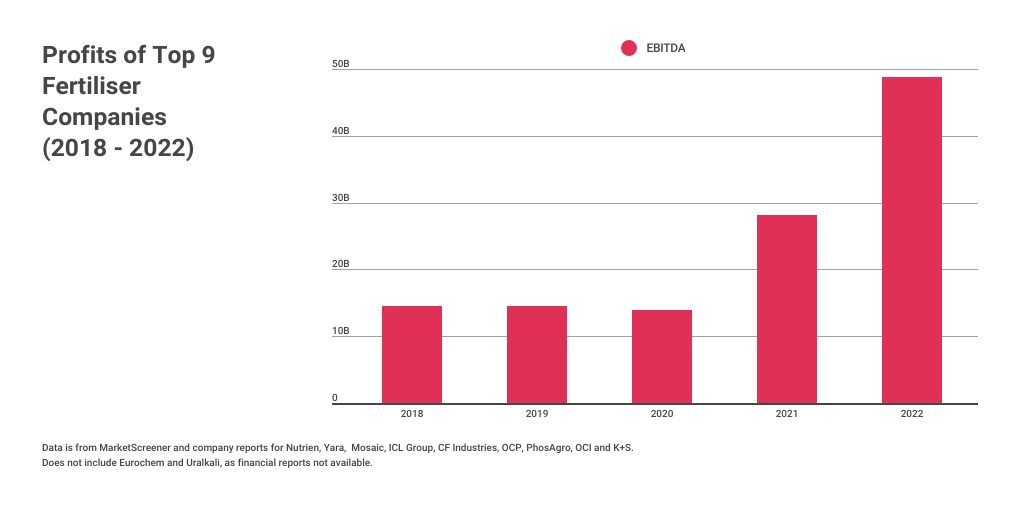Aquí puede leer la actualización en español. Vous pouvez lire la mise à jour en français ici.
Last year's financial results from the world's largest fertiliser companies are now in — and it's a shocker. Given the sky high fertilizer prices of 2022, it was anticipated that their revenues would break records, but no one could have predicted this scale of profiteering. As the world grappled with a severe food crisis and farmers saw costs rise, the world’s largest fertiliser firms ramped up their margins and more than tripled their profits from two years ago.

Graph 1 shows the total profits of the big nine fertiliser companies over the past five years. They exponentially grew from an average of around US$14 billion before the COVID-19 pandemic to US$28 billion in 2021 and then to an astounding US$49 billion last year. International agencies like the World Bank blamed the spike in fertiliser prices on the Russian war in Ukraine, resulting in high natural gas prices (used to produce nitrogen fertiliser) from shortages and trade disruptions. But as can be seen in Graph 2, a major part of the story is the monopoly power of the fertiliser companies. These companies increased prices far beyond the increases in production costs and boosted their profit margins to a massive 36% in 2022.

There are signs that fertiliser prices are coming down from their stratospheric heights earlier this year, but the effects of the price spike are still being felt. The high prices and lack of supply in some countries caused farmers to cut fertiliser use, thereby reducing production levels and contributing to an alarming rise in global food insecurity. The high prices also pushed many farmers deeper into debt. Farmers from Cameroon to the U.S. say they are still spending three times as much on fertilisers as they were a few years ago. And in countries where fertilisers are heavily subsidised, the price spike has saddled governments with huge debts. In India alone, the central government's expenditure on fertiliser subsidies last year surged from US$9.8 billion to US$17.1 billion. People are paying the price for the fertiliser industry's price gouging.
The costs are also rising for the planet. Chemical fertilisers are a major source of environmental pollution and greenhouse gas emissions, with nitrogen fertilisers alone accounting for one out of every 40 tonnes of annual emissions. New reports from the UN's Food and Agriculture Organisation and Earth4All, a global collective of leading scientists and economists, make it clear that steep and immediate reductions in global fertiliser use are required to avert catastrophic climate change. Both recommend a near phase-out of nitrogen fertiliser consumption by 2050 (see Graph 3). The idea is not to recklessly crash production levels, but a planned transition toward more sustainable, agroecological farming systems that require less or no fertiliser.

It is increasingly clear that today's food inflation is a product of both corporate greed and ecological breakdown. Obscene levels of profit-taking by corporations are happening across the food system, from fertilisers to processing to retail, and this is pushing up prices. But the way these corporations organise our food production and distribution is also driving climate change and undermining the capacity for the global food system to deliver affordable and accessible food, now and over the long term.
Bold new approaches are urgently needed to reign in corporate power in the food system and turn the food crisis around. When it comes to fertilisers, policy actions like windfall taxes and price controls can help. But to deal with both profiteering and environmental catastrophe we need to transition food production to rely far less on chemical fertilisers. The fertiliser industry will be pushing for the opposite when it gathers for its annual meeting in Prague this week, yet around the world there are farmers and rural movements already leading a transition away from chemical fertilisers, with plenty of successful examples to learn from. What's holding us back is the structural political change needed at all levels to address the excess profiteering from the fertiliser industry, and to chart a new path toward more resilient food systems.
Downloads & Translations
Download a PDF of the latest data complied on fertilizer industry profits.
Aquí puede leer la actualización en español.
Vous pouvez lire la mise à jour en français ici.